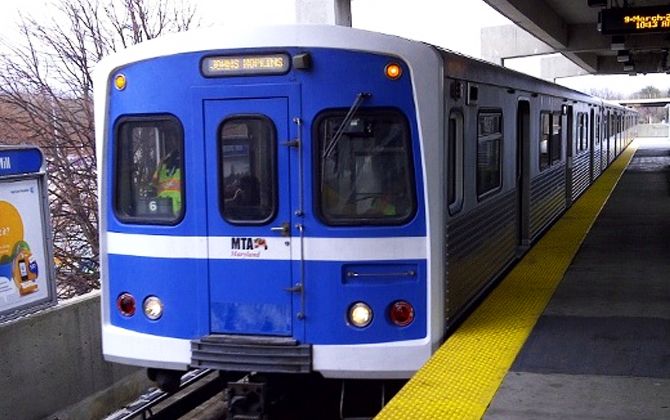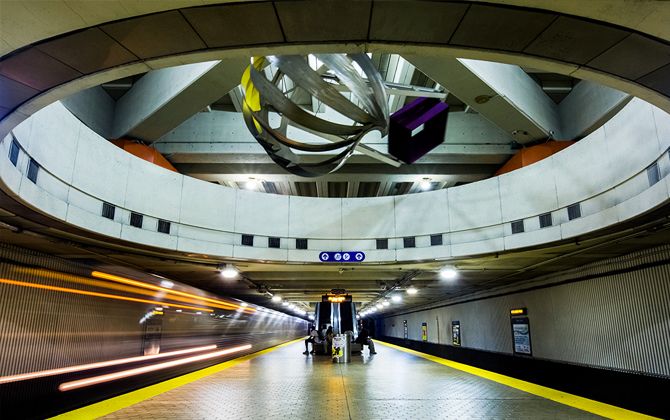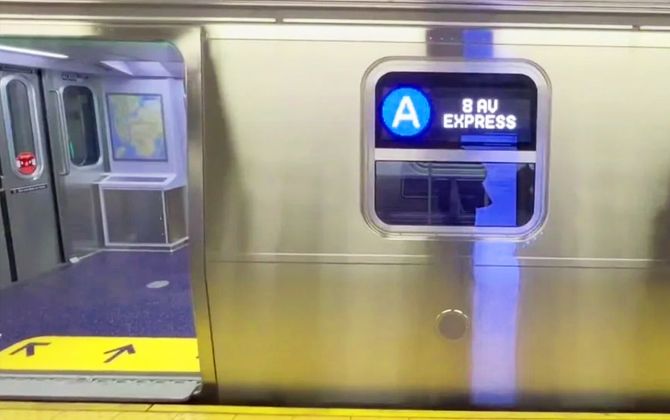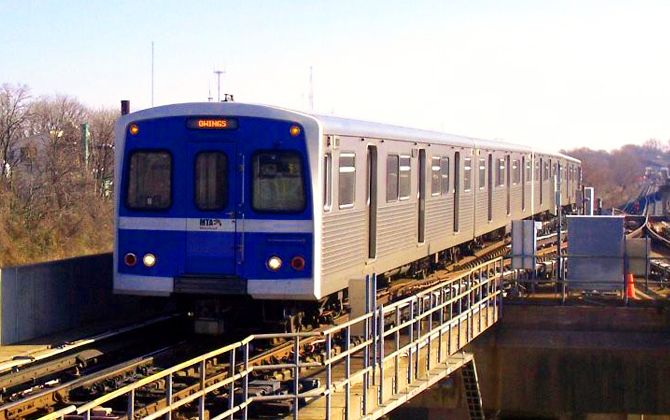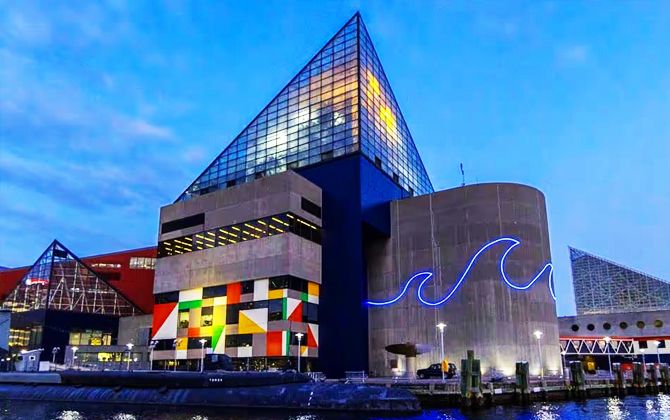The Baltimore Metro SubwayLink, also known as the “Metro Subway” or “Green Line,” is the city’s only heavy-rail transit line. It runs from Johns Hopkins Hospital in East Baltimore to Owings Mills in Baltimore County. The line is 15.4 miles (24.8 km) long and includes 14 stations, 8 of which are underground.
In 2024, the system carried about 5.49 million passengers, averaging roughly 15,200 riders per weekday in 2026. This makes the Metro SubwayLink a key part of Baltimore’s transit network.
Baltimore Metro Map
On system maps, the Metro SubwayLink is shown as a straight corridor running southeast to northwest. The downtown section, from Shot Tower to Charles Center, is entirely underground. Outside the city center, the tracks run on elevated structures or at ground level.
Official MTA maps (available in PDF) display all 14 stations along the route, with key transfer points highlighted. Notable transfers include the Light RailLink at Lexington Market and Cultural Center. On regional rail maps, the line is marked in green.
Map of Baltimore Metro showing different lines. Click on the map to enlarge it or download the Baltimore Metro map in PDF format.
Lines and Stations
The Metro SubwayLink has one line with 14 stations. Key stations include:
Owings Mills (terminus) – Suburban station in Baltimore County, located in the median of I-795. It is the northwest end of the line and the largest park-and-ride with about 3,500 spaces. Served by LocalLink 87 and 89.
Old Court – In Lochearn, Baltimore County. Opened in 1987 with about 625 parking spaces. Served by LocalLink 37 and 83.
Milford Mill – Near Milford Mill Road in Lochearn. Opened in 1983 with about 1,300 parking spaces. Served by LocalLink 81 and 85.
Reisterstown Plaza – At Wabash Ave & Schaefer Blvd, near Reisterstown Road Plaza mall. Opened in 1983 with about 700 parking spaces. Served by LocalLink 82.
Rogers Avenue – In the Woodmere area. Opened in 1983 with about 900 parking spaces. Served by LocalLink 28, 30, 31, 34, 80, 82, 89.
West Cold Spring – At Wabash Ave & Cold Spring Lane. Opened in 1983 with about 300 parking spaces. Served by LocalLink 28 and 82.
Mondawmin – Located under Reisterstown Road & Liberty Heights Ave. Opened in 1983, adjacent to Mondawmin Mall and near Druid Hill Park and the Zoo. Major transfer hub with CityLink NV, LM, YW and LocalLink 22, 26, 29, 82, 83, 85, 91.
Penn-North – At Pennsylvania & North Avenues. Opened in 1983. The deepest station, about 120 ft (36 m) below street level. No parking available. Served by CityLink LM, GD and LocalLink 85.
Upton–Avenue Market – At Pennsylvania Ave & Laurens St. Opened in 1983. Named for the Upton neighborhood and Avenue Market. No parking available. Served by CityLink LM (southbound). Features a large jazz-themed mosaic by Romare Bearden.
State Center (formerly Cultural Center) – At Preston St, beneath the state office complex. Opened in 1983. Connected by foot to the Light RailLink at Cultural Center station. Served by CityLink LM, YW; LocalLink 54, 73; Express BusLink 501; Commuter bus 410.
Lexington Market – Downtown station beneath Lexington Market in the Theater District. Opened in 1983. Direct pedestrian transfer to the Light RailLink at street level. Served by CityLink BL; LocalLink 54, 71, 80, 94; Express 105, 115, 120, 150, 501, 163; Commuter 320.
Charles Center – At Baltimore & Charles Streets downtown. Opened in 1983. The largest station and a major transit hub. Originally the terminus until 1995. Near M&T Bank Stadium and CFG Bank Arena. Served by CityLink OR, GR, SV, RD, PR; QuickLink 40; LocalLink 51, 56, 65, 67, 71, 76, 78, 95; Express 103, 105, 120, 150, 160; Commuter 210, 215, 310, 410, 411, 420; Charm City Circulator Purple route.
Shot Tower – At President & Fayette Streets. Opened in 1995. Named after the historic Shot Tower. Provides access to attractions such as the National Aquarium, Little Italy, Power Plant Live!, and the Flag House. Served by CityLink OR, BL, PR; QuickLink 40; LocalLink 54, 67, 76, 78; Express 105, 150, 501, 160; Charm City Circulator Green route.
Johns Hopkins Hospital (terminus) – At Broadway & Monument in East Baltimore. Opened in 1995. Direct underground access to Johns Hopkins Hospital via a dedicated entrance. Eastern terminus of the line. Features the art installation “Lost in the Cosmos” by Peggy Fox. Served by CityLink PK, GD, BR, LM; LocalLink 21, 56; Express 105, 115, 120, 160; Commuter 210, 215, 310, 320, 411, 420.
Operating Hours
A full trip on the Metro SubwayLink takes about 30 minutes. Service runs from 5:00 AM to midnight on weekdays, and from 6:00 AM to midnight on weekends. Trains arrive every 8 minutes during weekday rush hours and every 15 minutes late at night and on weekends. Full schedules are available on the stations.
Fares, Cards, and Tickets
Metro fares are integrated with the rest of MTA Baltimore transit.
| Fare Type | Full (USD / EUR) | Senior/Disability (USD / EUR) | Student (USD / EUR) | Mobility (USD / EUR) |
|---|---|---|---|---|
| Single trip | $2.00 / €1.85 | $1.00 / €0.92 | $1.50 / €1.38 | $2.20 / €2.03 |
| Day Pass | $4.60 / €4.25 | $2.30 / €2.13 | – | – |
| Weekly Pass | $22.00 / €20.30 | – | – | – |
| Monthly Pass | $77.00 / €71.00 | $23.00 / €21.20 | – | – |
Children under 5 ride free with a fare-paying adult. Tickets with magnetic stripes or QR codes are sold at station vending machines and can be paid with cash or credit cards.
The MTA also offers reusable fare options. The CharmCard smartcard was once used to load passes and pay fares. In 2024–25, the agency introduced the CharmPass mobile app, which supports features such as 90-minute free transfers and multi-day passes, and is gradually phasing out the CharmCard.
The Subway: Baltimore, Maryland
Connections
Every Metro station connects to one or more MTA bus routes. Some stations also link to Light Rail or MARC. Major connections include:
- Owings Mills: LocalLink 87, 89
- Old Court: LocalLink 37, 83
- Milford Mill: LocalLink 81, 85
- Reisterstown Plaza: LocalLink 82
- Rogers Avenue: LocalLink 28, 30, 31, 34, 80, 82, 89
- West Cold Spring: LocalLink 28, 82
- Mondawmin: CityLink NV, LM, YW; LocalLink 22, 26, 29, 82, 83, 85, 91
- Penn-North: CityLink LM, GD; LocalLink 85
- Upton–Avenue Market: CityLink LM
- State Center (Cultural Center): Light RailLink (Cultural Center); CityLink LM, YW; LocalLink 54, 73; ExpressBusLink 501; Commuter 410
- Lexington Market: Light RailLink (Lexington Market); CityLink BL; LocalLink 54, 71, 80, 94; ExpressBusLink 105, 115, 120, 150, 501, 163; Commuter 320
- Charles Center: CityLink OR, GR, SV, RD, PR; QuickLink 40; LocalLink 51, 56, 65, 67, 71, 76, 78, 95; ExpressBusLink 103, 105, 120, 150, 160; Commuter 210, 215, 310, 410, 411, 420; Charm City Circulator (Purple)
- Shot Tower: CityLink OR, BL, PR; QuickLink 40; LocalLink 54, 67, 76, 78; ExpressBusLink 105, 150, 501, 160; Charm City Circulator (Green)
- Johns Hopkins Hospital: CityLink PK, GD, BR, LM; LocalLink 21, 56; ExpressBusLink 105, 115, 120, 160; Commuter 210, 215, 310, 320, 411, 420
Notes: CityLink and LocalLink are Baltimore’s main bus networks. ExpressBusLink routes (100s) serve longer-distance city trips. Commuter buses connect Baltimore to suburban areas.
Reaching the Airport by Metro
The Metro Subway does not go directly to Baltimore/Washington International (BWI) Airport. Travelers can reach BWI by connecting with other transit. The most common option is to take the Metro to downtown and transfer to the MTA Light RailLink (Blue Line), which runs directly to BWI Marshall Airport. For example, exit at Lexington Market or State Center and board the Light Rail south toward Glen Burnie.
Another option from downtown is the MARC Penn Line, which stops at BWI Airport station.
Security
The Metro SubwayLink is generally regarded as safe. Media reports have ranked the MTA as the safest major transit agency in the United States. Still, passengers should follow basic precautions: stay aware of your surroundings, keep belongings secure, and avoid empty cars late at night.
The Maryland Transit Administration Police patrol the system. Stations are equipped with cameras and emergency call boxes. If you feel unsafe, contact a station agent or a police officer right away.
Subway Rules
Inside the facilities
- Eating is permitted on Baltimore Metro facilities, but if the food produces an odour that disturbs other passengers, a security officer has the authority to remove the offending passenger from the train. If the passenger resists, he or she may even be arrested and cautioned.
- Smoking is not permitted in the carriages or on the premises. Failure to comply with this rule may result in a fine.
- Disturbing the peace and quiet of other passengers on trains by shouting or talking excessively will result in a reprimand from the security guard.
- Listening to music on devices such as radios, MP3 players or iPods without headphones is prohibited.
- Panhandling (begging for money) on trains or in MTA facilities is prohibited. This action may result in removal from the train or station.
- Passengers are advised not to obstruct the closing of car doors. Doing so intentionally may result in a reprimand from the security guard.
- Passengers are advised to let other passengers off the train before boarding. This helps to maintain order in the transport system.
Bicycle transport
- Passengers are allowed to take their bicycles with them on the Metro and Light Rail as long as they are kept next to the passenger and are not used on the premises.
- Passengers are only allowed to take two bicycles at a time in the same carriage. The user must ensure that his bicycle does not obstruct the free passage of other passengers in the aisles.
- Passengers cannot force their bicycles onto trains that are too full. If this is the case, they must wait for another train.
- Transport of bicycles on trains may be prohibited due to unusual circumstances.
- Elderly and disabled passengers will be given priority over bicycles when boarding trains.
- Disabled passengers who require the use of a bicycle to assist with their condition may have it with them on the premises at all times.
- Cyclists under the age of 16 must be accompanied by a parent or guardian on the Underground.
- Users who fail to comply with the above rules may be penalised by the MTA Security Team. Punishment may range from a fine to arrest.
Pet Transportation
- Pets can be transported without inconvenience during off-peak hours. However, during peak periods, the carriage of pets may be restricted.
- Dogs must be leashed and muzzled, must not occupy seats in the carriage and must not disturb other passengers.
- During peak periods, small animals should be transported in appropriate containers so as not to cause discomfort to other passengers.
Historical Overview
The Metro traces back to a 1965 regional plan that proposed six rail lines radiating from downtown. Over time, the plan was reduced. Phase 1, approved in 1972, included a northwest line to Owings Mills and a south line to Glen Burnie. The south line was canceled in 1975 due to political pressure, and that corridor was later served by Light RailLink instead.
Construction started on the northwest line. The first 7.6 miles (12.2 km) opened on November 21, 1983, from Charles Center to Reisterstown Plaza. On July 20, 1987, the line was extended another 6.1 miles (9.8 km) to Owings Mills, with part of the route in the I-795 median. The final 1.6-mile (2.6 km) extension ran east from Charles Center to Johns Hopkins Hospital, opening on May 31, 1995.
By 1995, the system totaled 15.4 miles (24.8 km) with 14 stations. The full project cost about $1.392 billion (≈€1.28 billion). At the time of opening, the Metro became the largest single user of Susan B. Anthony $1 coins in the country.
Future Extensions
No extensions are currently under construction. In the early 2000s, a plan called the “Green Line extension” proposed extending the Metro northeast from Johns Hopkins Hospital toward Morgan State University and White Marsh. Progress has been limited. Recent studies focus only on a shorter 4-mile (6.4 km) segment to Morgan State, and alternatives such as bus rapid transit or light rail are being considered.
As of 2026, the Metro SubwayLink extension remains a concept. No funding or firm construction plans have been approved.
Tourist Attractions
Several of Baltimore’s main attractions can be reached by Metro, often with short walks or transfers:
- Inner Harbor & Aquarium: From Shot Tower station, walk a few blocks to the National Aquarium and Inner Harbor.
- Lexington Market: The historic downtown market sits directly above Lexington Market station.
- M&T Bank Stadium & CFG Bank Arena: Near Charles Center station. Exit onto Charles Street for a short walk.
- Baltimore Zoo & Druid Hill Park: From Mondawmin station, transfer to a bus or Light Rail for a quick ride to the park and zoo.
- Little Italy & Fells Point: Both neighborhoods are a short walk from Shot Tower or nearby Light Rail stops.
- Johns Hopkins Hospital: The eastern terminus provides direct access to the hospital campus and medical museum.
All Metro stations connect to the MTA bus system, making it easy to reach museums such as the Walters Art Museum and Peabody Institute, as well as the University of Maryland and other destinations.
Fun Facts
- Safest system: A 2017 study named Baltimore’s MTA the safest major U.S. transit agency, with crime rates dropping significantly.
- Dollar coins: When the Metro extended in 1995, it became the largest single user of Susan B. Anthony $1 coins in the country.
- Deepest station: Penn–North sits about 120 feet (36 m) underground, the deepest on the line.
- Pop culture: Shot Tower station appeared in House of Cards as a fictional Washington, D.C. metro stop.
- Public art: Upton–Avenue Market station features “Baltimore Uproar,” a 1997 jazz mosaic by Romare Bearden valued at over $100,000 (≈€92,000).
- Park-and-ride: Owings Mills has about 3,500 parking spaces, the largest facility in the system, part of a major transit-oriented development.

